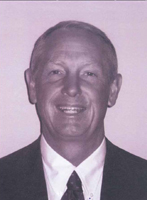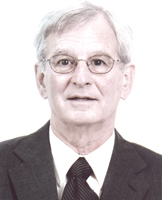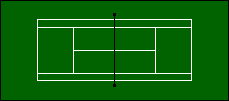 |
||
 |
 |
 |
Mike Barnes Sterling Heights Stevenson |
Steve Bender Buchanan |
Albert Kaye, Jr. Allen Park |
(click on Inductee's name to read 'description')
 |
||
 |
 |
 |
Mike Barnes Sterling Heights Stevenson |
Steve Bender Buchanan |
Albert Kaye, Jr. Allen Park |
(click on Inductee's name to read 'description')

 Mike Barnes , Sterling Heights Stevenson High School
Mike Barnes , Sterling Heights Stevenson High SchoolTalk about starting from nothing. In the early ‘70s, Mike Barnes began a tennis program at Sterling Heights Stevenson at the club level. A football, wrestling, and track athlete at James Whitcomb Riley High School in South Bend, Indiana, his wife was the one who got him playing tennis, an activity he continued with three fellow teachers during his first few years of teaching. In 1974, a group of students talked him into sponsoring a tennis club. He started teaching a group of 10 to 15 students “with help of some books and anyone I could find to give me some pointers.”
In 1977, the club members petitioned the Utica Community Schools to initiate a varsity tennis program. The district added varsity tennis to the athletic program in 1977-78. Mike has been the varsity coach ever since. In 1981, he took over the girls program after their second season. In other words, he is the school’s one and only tennis coach.
It wasn’t easy at first. For ten years, Mike’s kids practiced on three courts and had to play all of the school’s home matches at a neighboring school. Eventually the number of players became so large that he had to run two practice sessions each afternoon. But three more courts were built in 1988. The program now has 40 to 50 participants each season with paid and volunteer assistants making a considerable difference.
Sterling Heights is not a tennis community. The tennis club which resided nearby has since become a soccer house, thus the nearest tennis facility is a 30-minute drive away. Most of Mike’s kids hadn’t played the game before they got to him and “had to be taught everything.” Thus, Mike has run a summer tennis clinic. He started an informal camp 25 years ago and then for the past 12 years has been working through the UCS --the Utica Community Schools, the second largest district in Michigan is comprised of Utica Henry Ford II, Utica Eisenhower, Utica High School, and Sterling Heights Stevenson -- to run a camp for 80 to 125 players ranging from beginners 8 to 12 to advanced high school players. “He brings tennis to the masses of Macomb County,” says Fuzz Corey, Hall of Fame Class of 2001.
He also hosts tournaments. Mike has directed ten boys and 11 girls regionals and for 20 years, has hosted a Saturday event for the four UCS high schools, both boys and girls (total: 40). He has also hosted an equal number of Saturday invitationals over the years and at least 8 league tournaments.
This is remarkably generous given the fact that Mike has not enjoyed taking home many of the trophies. “We always have at least one team from the pool of Grosse Pointe South, Port Huron Northern, Troy, or Rochester in our regional,” he says. “When only one of them is in the regional, Eisenhower has most often been the team to come in second. We won our regional in 1994. Our last trip to the finals was in 2004.”
To be sure, colleagues have appreciated his efforts over the years. “When one plays against Mike’s teams, one knows that the players will know the rules, that they will show good sportsmanship (and if they don’t – which rarely happens – they will be immediately reprimanded for it),” says Fuzz. “He is complimentary to players of other teams. He is in it for the good of the game.” Dave Fredette of Armada (Hall of Fame Class of 1988) agrees. “Most years his teams would edge us out or defeat us soundly but either way, Stevenson has always been good competition and their players always have displayed sportsmanship and class whether they won or lost,” he says.
Characteristically, Mike doesn’t give himself much credit for the above. “What I am most proud of is really due to the quality and character of the players I have been blessed with over the years,” he says. “We have not had many elite players; however, their hard work and sportsmanship have been characteristics that I have been honored to be associated with.”
He also gives substantial credit to George Rouman, his assistant for 15 years who is co-director of the summer program. “His love of the game is what pushed me beyond the level of ‘recreational player,’ back before we had a team at Stevenson,” he says. George received the assistant coach of the year award in 2003. Tennis Coaches from Macomb County who are in the Hall of Fame include John Burke of St. Clair Shores South Lake, Don Wisswell of Mt. Clemens, and Bob Murray of Warren Woods Tower. Mike is in good company.
So are they.
| Back to Top |
 Steve Bender , Buchanan High School
Steve Bender , Buchanan High SchoolSteve Bender learned the game of tennis from his father, Michigan High School Coaches Association and Michigan High School Football Coaches Association Hall of Famer Don Bender, who coached football, basketball, and track in Niles for over 40 years. “I ran track in 7th grade – primarily to keep my dad happy,” he says. “Some of my friends convinced me to start playing tennis the summer between 7th and 8th grade, and I have been hooked since.”
Steve played for Niles High School from 1971 to 1974. In his junior year, his squad won the conference championship with a 4-3 win over powerful Kalamazoo Loy Norrix. In his senior year, the team beat Sturgis 4-3 (a group coached by Hall of Famer Harley Pierce,Class of 1986). Sturgis had won multiple state titles during that era. Steve played two seasons at Albion College but “They had too many quality recruits from Grosse Pointe University Liggett which knocked me out of the playing rotation.”
However, he stayed in the game by working for the Niles Recreation Department teaching tennis. His adult high school career began as an English teacher and varsity track coach at Buchanan, which he did for eight seasons (5 conference and 1 regional championship). But a tennis opening occurred in 1989. “I jumped on the job and it has been the greatest thing I have ever done at Buchanan,” he says.
Indeed. The numbers are nothing short of astonishing. Steve’s teams have enjoyed 10 undefeated seasons. They put together 58 conference dual wins in a row and a total of 66 consecutive dual match victories. They captured 16 Lakeland Conference championships, won 14 regional championships, and made 17 trips to the state finals. They finished in the top ten of the state 15 times, in the top five 8 times, and in the top four 7 times. They were state champions in 2003.
Twenty three of Steve’s kids have been all-state. Three were honorable mention. These kids helped capture 74 tournament trophies. Eleven of his teams were academic all-state. His record to date at Buchanan is 200-16-8. For his efforts, Steve has been elected regional coach of the year 14 times. He was state coach of the year in 1995 and in 2002.
It hasn’t been easy. Normally, a program with Steve’s success and stature ultimately gets the attention of the board of education with a “reward” of upgraded facilities. But for over two decades Steve has been pushing his school district for new courts – they only play on four – but “Our past superintendent stated that if we can win a state championship on 4 courts; why build more?” As a result, Steve hosts meets and tournaments – including both boys and girls regional and conference tournaments since 1995 – on a beautiful arrangement: 15 courts on one site, in Indiana.
This is a successful grass roots build-up. Steve started the Buchanan Middle School Tennis Club 22 years ago. For 22 years, he has run a youth summer program for grades 2-8 for 60-90 kids. Every summer, he has been giving tennis lessons to girls and boys of all ages for free (“I have never charged a penny”). As assistant athletic director in 1999, he started the girls tennis program at Buchanan but didn’t coach the team because he was coaching two of his daughters in girls basketball. Every year, Buchanan hosts two indoor events and one outdoor tournament. “It is a family joke when they (his family) annually say, ‘See you in June.’”
With lots of work and fund raising, Steve has been able to take his team to the Delray Beach Tennis Center 8 times. Two of his players have coached varsity tennis one at Muskegon Mona Shores and the other at Jackson Lumen Christi. Three of his players have served as his JV coach. His oldest daughter, who played tennis at Albion College, is now the boys JV coach at Edwardsburg. Every year, a highlight occurs with the alumni vs. varsity tennis match. “This is a special three-hour bond where our high school players see that this truly is a sport of a lifetime – and that tradition never graduates,” he says.
Buchanan is a small rural school with limited facilities but high moral principals, thanks to Steve. “One evening as practice was concluding, Coach Bender’s star number one singles player cursed at his mother in the presence of Coach Bender,” says a parent. “Coach Bender immediately told him to apologize to his mother and then he had him run laps on the track….Over the years, Buchanan has lost some excellent tennis players because they did not follow the rules….When we first started attending tennis matches, Coach Bender taught us about tennis etiquette and he continues to do that with the new parents as they start attending the program….. He makes sure that the players pick up the trash when they leave and that they are good sports on and off the courts.”
Thus, on multiple levels, Steve has been successful. “I have been truly blessed to be surrounded by so many wonderful players, parents, and coaches,” he concludes. “It has been an honor and a pleasure to give something back to Buchanan for what the sport of tennis has provided me.”
Our turn to do the giving.
| Back to Top |
 Albert Kaye, Jr., Allen Park High School
Albert Kaye, Jr., Allen Park High SchoolThe stereotypical Hall of Fame tennis coach builds a program from nothing. Over time, he becomes the Mr. Tennis of his high school – and sometimes the community. Without his long-term effort and commitment, the program would diminish, perhaps even fade away.
But Al Kaye’s situation takes the above scenario to extremes. When he first started coaching at Cabrini, he had the use of only four courts which faced the wrong way (east and west instead of north and south) and with chain link fencing for nets. Eventually, he put in a fifth court and then added a couple of inches of asphalt over the existing surface to gain a more level surface, but these courts were still not good enough to host matches. For a time his kids had to play their matches at the local swim and tennis club (After all, he was a board member and president). Eventually, he secured the use of city courts at Champaign Park, located next to Allen Park High School (He was on the city planning and zoning commission for years).
To be sure, his work situation didn’t always help. As a mechanical engineer at U.S. Steel in Ecorse, Al’s schedule was at first fortuitous in terms of finding time to coach high school tennis. He worked from 6:00 a.m. to 2:00 3:00 p.m. on weekdays but it had a bit of flexibility. However, when the company cut supervisors in 1994, he was put on shift work which made his schedule “interesting” (his word). He had to work 7 afternoons (2:00 to 10:00), get a couple of days off, then work 7 days (6:00 to 2:00), get a day off, and then work 7 midnights (10:00 p.m. to 6:00 a.m.). Then start over again. Al made the time to coach his high school players by trading shifts, using vacation days, and sometimes getting someone to cover. “When midnights came, it was sleep when you could,” he says.
“I was addicted to helping the kids,” he says. The only sports at the school were swimming and tennis, the latter program he describes as fading at the time. “I played a lot of sports but I did not play tennis until I joined the local summer tennis and swim club in 1976 when I was 35 years old,” he says. “I learned how to play on the courts. My son and daughter took lessons and I watched.” A year before his son entered 9th grade, Al offered his services to the athletic director at Cabrini, telling him that he knew very little about coaching but that he had played for a few years.
He got the job at once and immediately began attending the MHSTeCA annual clinics. “I have not missed a clinic,” he says. “I have learned everything I know from the clinics and the devoted coaches that are always willing to help.” These coaches include Hall of Famers Stan Noland of Monroe St. Mary’s (Class of 1998), Dick Morley of Whitehall (2000), Dean Sousanis of Almont (1996), John Shade of Grosse Ile (1993), and Bob Wood of University Liggett (1986).
It is an understatement to say that winning tennis matches at Cabrini has not been easy. Virtually every year, either Al’s Cabrini squad or Barb Myler’s Royal Oak Shrine crew would come in third behind Brother Rice and Detroit Catholic Central in the boys season or Marian and Farmington Hills Mercy in the girls campaign. In addition, he experienced more than his share of third place finishes (seven for boys and six for girls) at the regional behind Grosse Pointe University Liggett, Ann Arbor Greenhills, Grosse Ile, Detroit Country Day, or Bloomfield Hills Sacred Heart Academy. Nevertheless, one girls team captured a regional trophy and two of them went to the state finals, finishing 7th and 13th. Seven of his boys squads found themselves in final tournament action, the highest finish being 8th. In league play, Cabrini boys have finished 1st in their division 15 times out of 25 seasons. The girls have finished 1st nine times out of 22 seasons.
Al’s hard work has certainly been recognized and acknowledged. Over the years, he has been voted regional coach of the years five times for girls and another five times at the end of the boys season. He was elected state boys coach of the year in 1992.
And he is one of four tennis coaches inducted into the Catholic League Hall of Fame. They include Jim Kerwin of Farmington Hills Mercy (1991 MHSTeCA DSA and 1987 Girls COY), Julie McKnight of Bloomfield Hills Marian (Hall of Fame Class of 1999), and Barb Myler of Royal Oak Shrine (Hall of Fame Class of 2008).
He joins two of the above for a well-deserved additional honor.
| Back to Top |